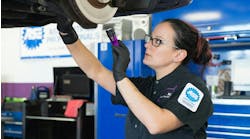Put me in, coach: How driver coaching decreases maintenance
While we at Fleet Maintenance tend to focus more on technician training over driver training, there is a tangible link between safer drivers and less maintenance for understaffed shops.
“Driver behavior has a huge impact on [vehicle] wear and tear,” Craig Marris, chief sustainability officer and EVP for mixed fleets in North America for EROAD, told Fleet Maitnenance last year. “If you're hard on a vehicle with rapid acceleration, hard cornering, if you're not using cruise control, or you’re hard shifting, rapidly accelerating, all that is not good.”
In fact, Environmental Protection Agency tests indicated that heavy braking and quick acceleration can reduce fuel economy by 33%.
As a result, Marris noted that simply through driver behavior changes, one of EROAD’s customers found that within six months, “safety improved, mpgs improved massively, and maintenance costs came down.”
But setting up a driver coaching program to encourage these behaviors is easier said than done. So, here’s a few tips from fleet experts on how they established their training regimes.
Establishing a training program
Ben Hernandez, a sales service manager in Houston for Silver Eagle Distributors Houston, found that an important first step to any training directive is to get drivers on board for the program.
“First and foremost is just getting everybody to buy into the program itself,” Hernandez explained. “You have to relate to them, you have to get them understand that ‘I’m not doing this for me, I'm doing it to try to help us be safer out on the roads.’”
Once that’s done, it’s critical to establish your program’s timing and consistency, as well as how you’ll deliver feedback and set measurable goals for your employees. Ingo Wiegand, VP of Product Management for telematics and coaching technology company Samsara, recommends that fleets first identify their safety priorities with reporting data. Then, they should focus on what Wiegand calls “leading indicators”, or habits that drivers can correct with the help of in-cab alerts. A couple examples of this is monitoring safety events such as harsh braking, speeding, or following distance violations. Then, be sure to communicate these goals and indicators to the drivers themselves.
“Consistent communication that coaching and training are meant to improve and retain drivers gives the coaching program a better chance of success,” said Brandon Wooden, transportation training manager for J.J. Keller’s Safe & Smart Driver Training Program. “Companies instituting a driver training program without establishing a foundation and vision for success will struggle.”
To avoid overwhelming drivers with these reminders and goals, a careful implementation approach is also a good idea.
“To address challenges effectively and build a coaching program that lasts, we often see success with a gradual approach,” Wiegand advised. “Fleets can even break things down into beginner, intermediate, and advanced buckets to ensure a smooth transition.”
Finding good mentors
Of course, no coaching program is complete without trusted employees to do the coaching. According to Wooden, coach criteria should go beyond their driving skill, but should include the mentoring aptitude and experience, even if their prior experience is as simple as coaching a little league team.
Read more: Product Spotlight: AI Dash Cams
“Many companies select trainers based on driving success and longevity,” Wooden said. “However, it is vital that a trainer/coach, with the skills and knowledge, be able to gain acceptance for behavior changes with the driver to achieve the intended outcome.”
This is helped when the coach is a former driver themselves, as is the case for Silver Eagle Distributor Houston’s Hernandez, who drove routes for six years. But even if your chosen coaches aren’t former drivers, their attitude and approach can still be effective as long as they appreciate and affirm their mentees. This will go a long way to creating the trust needed between a driver and their coach, noted Jeff Martin, VP of global sales strategy for Lytx, a company that provides video safety and telematics technology that can assist in driver coaching.
One way to encourage this trust is through training for mentors and coaches.
“One best practice that a lot of companies are doing today is roleplay,” Martin stated. “They'll have managers roleplay with one another, and it sounds corny, but it's highly effective both in training and developing managers.”
Using technology for coaching
For many coaching programs, being able to catch problem behaviors and then correct them is key, both for educating drivers, and decreasing safety risks and wear and tear on their vehicles.
“A few specific technology investments that can bolster a driver coaching program include AI-powered dash cams, in-cab alerting capabilities, and telematics solutions that provide real-time insights,” noted Wiegand. “Telematics devices can provide data on speed, g-force, GPS location, and more – providing additional context into driver safety.”
Martin noted that Lytx’s Video Safety Program provides similar opportunities to identify unsafe behaviors early on, from traffic incidents to potentially serious accidents. Other such options include J.J. Keller’s Dash Cam Pro and Encompass Video Event Management cameras. However, approaching drivers with this technology can be difficult, due to driver concerns surrounding privacy and pride in their expertise.
“What may be even more important than the technology itself, however, is how that technology is used,” Wooden said. ‘Drivers will ask, “Is the camera there to catch me making a mistake, or is it used to help me improve my skills and protect me if I am doing everything right?’ Positive reinforcement during training and periodic recognition based on situations picked up by the camera are critical.”
With these tools and tactics in mind for a coaching program, both drivers and the vehicles they work with will be in a better position on the road.




